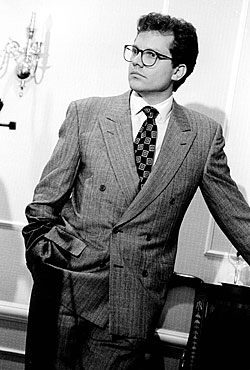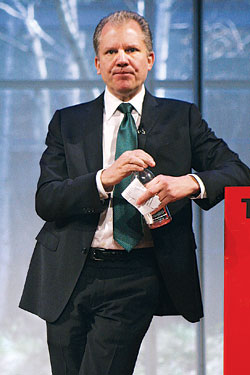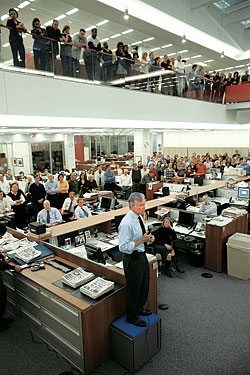
Two weeks ago, I went to the New York Times’ gleaming, modernist, Renzo Piano–designed headquarters on Eighth Avenue in Manhattan to discuss some good financial news with Arthur Sulzberger Jr., the paper’s publisher and the chairman of the New York Times Company. Good news has been in short supply in the world of dead-tree media, and for the Times in particular.
For much of Sulzberger’s nineteen-year tenure, the paper that his family has controlled for more than a century has been embroiled in one crisis or another, ranging from the Jayson Blair fiasco, which led to the overthrow of Howell Raines, the hard-charging editor who had been handpicked by Sulzberger, to the paper’s reporting on the phantom WMDs in Iraq, which some believed had even helped propel the U.S. into war.
Then there were the paper’s financial troubles, which appeared to have pushed it to the brink of extinction. For well over a decade, the Internet had been relentlessly consuming the paper’s business model. On the web, the saying went, information wants to be free; this left institutions like the Times, which invest huge sums in reporting the news, in an existential quandary. In the months after the collapse of the credit market in the fall of 2008, the company was forced to take drastic measures to stay afloat: In January 2009, it granted Mexican telecom mogul Carlos Slim Helú purchase warrants for 15.9 million shares of Times Company stock for the privilege of borrowing $250 million at essentially a junk-bond interest rate of 14 percent. Two months later, in a move redolent with uncomfortable symbolism, the company raised another $225 million through a sale-leaseback deal for its headquarters—which had been built only two years earlier and which, in its understated, environmentally conscious, progressive, user-friendly way, was supposed to be the emblem of the paper’s 21st-century identity. Add on double-digit declines in both circulation and ad pages and the trend lines looked increasingly clear: The New York Times was doomed.
But a funny thing happened on the way to the graveyard. Though the Times’ circulation dipped during the crash years, much of the lost revenue was made up for by doubling the newsstand price, from $1 to $2—evidence, the paper insisted, that its premium audience understood the value of a premium product. In March, after several years of planning and tens of millions in investments, the Times launched a digital-subscription plan—and the early signs were good. In fact, less than 48 hours before my interview, the Times announced it would finish paying back the Carlos Slim loan in full on August 15, three and a half years early. When they were released last week, the company’s second-quarter financial results showed an overall loss largely owing to the write-down of some regional papers, but they also contained a much more important piece of data: The digital-subscription plan—the famous “paywall”—was working better than anyone had dared to hope.
Meanwhile, a phone-hacking scandal was engulfing Rupert Murdoch and News Corp. This was not in itself relevant to the Times, but it carried its own symbolism. Murdoch had made a point, after his purchase of The Wall Street Journal, of suggesting that the Times was vulnerable. “Let the battle begin,” he wrote in a note to Sulzberger. Sulzberger would not be quite human if he didn’t take some satisfaction in his rival’s troubles, especially because an aggressively reported investigation the Times published in its magazine last September was critical in bringing the scandal to light.
The bottom line for the paywall is more than the bottom line: The Times has taken a do-or-die stand for hard-core, boots-on-the-ground journalism, for earnest civic purpose, for the primacy of content creators over aggregators, and has brought itself back from the precipice. And if that does indeed end up being the case, there’s one unlikely person who deserves most of the credit: Arthur Ochs Sulzberger Jr.
Sulzberger has a great story to tell. After all, it was he who made what appeared to many to be a quixotic bet on quality at precisely the moment when the world looked like it was moving in the other direction. But after years of public excoriation, he’s highly wary of telling it. (“Think of him as an abused dog,” one of his colleagues told me. “It’ll take him a while to trust again.”)
When I tried to prompt him by reminding him of all the pundits who’d predicted the paper’s collapse, he refused to take the bait. “Sorry,” he said, popping up from his chair, “I’ve got to get something. I mean—that’s funny, I was recently reminded of the columns that the New York Post had written just after I became publisher about how awful I was.” He reached into a drawer and pulled out a dog-eared copy of a magazine from August 1977.
“I’ve always kept this one,” he said. “This is the Time magazine piece on my father about how he was such an awful publisher that the newspaper wasn’t going to survive.” The cover features an illustration of Sulzberger’s father in bed, surrounded by copies of the Times’ “light” news sections—“Home,” “Living,” and the like. The headline reads, “Coping With the New New York Times,” and the story, Sulzberger told me, was about how his father “was destroying the paper; it’d never been in worse shape. By the way, [that] was just months before they launched the four-section daily, remade the entire paper”—an illustration, Sulzberger said, of how “people don’t have the insight they think they have, and so they react, too frequently, in the moment.” As it turned out, the piece was a fairly positive account of his father’s effort to remake “America’s greatest newspaper”—evidence, if more were needed, of the painfully thin skin of a man who has spent decades on the defensive.

Speaking of the digital-subscription plans specifically and the company’s financial future more generally, Sulzberger says, “Let’s be clear—we’re three months into this. It proves that we’re on a good track, better than we had imagined, but we’ve got to continue to invest. We’ve got to continue to change and adapt and grow from this experience. And we will.”
That’s a truism Sulzberger’s staff seems to have increasing amounts of faith in. Departing executive editor Bill Keller, who got his job only after Raines was fired, says, “My relationship with Arthur is always going to be a little complicated by the fact that I was his second choice … But boy, I look around the country and I can’t see anybody I would want to trade for Arthur Sulzberger.” The commitment to spending money and resources on expensive and oftentimes dangerous reporting is, Keller says, something Sulzberger views as “sacred—and he gets a lot of credit in my book for that.”
Sulzberger made what appeared to many to be a quixotic bet when the world looked like it was moving in the other direction.
Ever since 1992, when the then-40-year-old Sulzberger was tapped as the fifth member of the Ochs-Sulzberger clan to serve as publisher of the Times, there has existed a fundamental paradox at the heart of any assessment of the paper and its future. For more than a century, the family’s stewardship has been recognized as the primary reason for the Times’ enduring excellence. (As former executive editor Max Frankel once said, “I thank God for that monarchy, because every other newspaper that has lost its family control has gone to seed.”) But even before Sulzberger, or “Young Arthur,” as he is still sometimes referred to, took over after the 29-year reign of his father, there were grumblings that he wasn’t cut out for the job: The bright-eyed, occasionally New Age–y, motorcycle-riding, baby-faced heir could come across as callow, insecure, and undisciplined. The sharp bark of a laugh that punctuated his jokes when he was nervous made people uncomfortable. And, of course, he was the scion, which can be a hard row to hoe: Crowns have their advantages, but they also invite ridicule. All in all, Sulzberger, as one Times executive recently put it to me, is “an easy guy to caricature … He becomes a figure of fun and does not seem like a commanding … forceful leader.” In fact, Sulzberger’s apprenticeship in journalism and at the Times far outstripped that of his revered father, known by his childhood nickname, Punch (or, for that matter, of his grandfather, Arthur Hays Sulzberger, who served as publisher from 1935 to 1961). After graduating from Tufts in 1974, Sulzberger moved to North Carolina to work as a rookie reporter for the Raleigh Times. In the mid-seventies, he worked for the Associated Press in London, and after arriving at the Times, he worked as a reporter and an editor, did a stint in the paper’s advertising department, and even worked the night shift in the production department.
But skepticism seemed to stick to Sulzberger regardless of how much effort he put in. Some of this undoubtedly stemmed from his relationship with his father. (When Sulzberger was in his mid-twenties, his father included the following sentence in a job recommendation for Sulzberger’s then-wife: “We think she is smarter than he is.” It was only on his secretary’s insistence that the letter was rewritten.)
Of course, Punch had been beset by many of these same criticisms when he was named publisher in 1963—but he was able to grow into his role as the clan’s and the company’s elder statesman during a time when newsroom sniping and industry gossip were traded over cocktails at the Century Club and not leaked to “Page Six.” What’s more, Punch’s ascension occurred when the paper could hum along without worrying about anything as prosaic as business plans or fiscal projections.
Contrast that with the seismic upheavals that have rocked the media industry over the past two decades. When Sulzberger looks around, he sees a landscape littered with the corpses of his onetime competitors. Once-proud newspaper dynasties like the Taylors of the Boston Globe, the Chandlers of the Los Angeles Times, and, most recently, the Bancrofts of The Wall Street Journal have collapsed, owing to economic pressures, familial infighting, ongoing incompetence, or all of the above. Three years ago, the Tribune Company, owner of the Chicago Tribune, the Baltimore Sun, the Los Angeles Times, and many other papers, declared bankruptcy; the companies that control the Minneapolis Star Tribune, the New Haven Register, and both Philadelphia dailies did as well. (With the exception of the Tribune Company, all of those companies have emerged from bankruptcy protection.) In the first half of 2009, Denver’s Rocky Mountain News (founded 1859), the Seattle Post-Intelligencer (founded 1863), and the Tucson Citizen (founded 1870) all ceased publication.

With the benefit of hindsight, it seems clear that Sulzberger’s first big initiative—to transform the Times from a regional paper with national scope to a national paper that happened to be headquartered in the Northeast—was a smart one. In the mid-nineties, the Times’ print-side balance sheet was in decent shape, and yet Sulzberger, along with a group of editors and executives that included Times Company CEO Janet Robinson, set about trying to persuade advertisers to fundamentally reconsider their relationship with the paper.
Sulzberger’s “national strategy,” which involved substantial investments in new printing plants and distribution efforts, coincided with a boom in luxury advertising, and within a couple of years, the plan was working. But even as the ad revenue continued to funnel in, there was a new problem looming on the horizon. The Times, like every other newspaper and magazine in the world, was confronted with the strange, new, virtual world of the Internet. Compared with some of his peers, Sulzberger was an early adopter. By the turn of the century, he had a new mantra: He was “platform-agnostic.” In other words, it didn’t matter how you consumed your news so long as you were eating from his newspaper’s plate. Years before the advent of smartphones or iPads, he told me that one of the company’s most pressing goals was to figure out how to reach all the “people we think have an affinity for the Times’ news organization who currently don’t read the Times, either because they can’t get access to it or they may not read it because they don’t read newspapers and they want to access that information [some other way].”
That type of talk might have sounded good at TED conferences and Sun Valley retreats, but it didn’t help relations between the paper’s print and online staffs, which had existed as separate entities since the founding of Times Company Digital, the paper’s Internet company, by Martin Nisenholtz in 1995. From early on, The New York Times on the Web, as the paper’s site was officially called, excelled at creating powerful online content. In 1999, Nisenholtz and his team had put together a database of more than 10 million registered users and had annual revenue of $25 million.
The primacy the company put on its digital operations fueled tension in the newsroom. The subsequent years felt at the time like a perpetually mutating quagmire: There was the bursting of the dot-com bubble; the eventual merging of the print and digital newsrooms; and the odd, ill-fated TimesSelect plan shut down when the paper realized that whatever revenue was being earned by putting most of its columnists behind a $50-a-year paywall was more than offset by the eyeballs it was losing.
Through it all, Sulzberger plowed money into the Times’ web operation—and by 2008, nytimes.com had become one of the most impressive news sites on the planet.
Not that that meant much to the company’s creditors. In the fall of 2008, when the bottom fell out of the credit market, the Times Company appeared to be in danger of defaulting on a good portion of more than $1 billion in outstanding loans. Early the next year, TV executive and media maven Michael Hirschorn parsed the numbers and argued in the pages of The Atlantic that it was “certainly plausible” that the Times could go out of business as early as May 2009. Even if the paper (and the company) survived, Hirschorn wrote, there would be “significant and traumatic change”—and at some point in the not-so-distant future, the Times as it currently existed would cease to be.
The anxiety at the Times, and in the media in general, was often overpowering. That spring, I was at The Four Seasons for a party celebrating the release of Street Fighters, former Wall Street Journal reporter Kate Kelly’s book on the collapse of Bear Stearns. As I was getting ready to leave, a Times business reporter took me aside and asked whether I thought it was time to look for a new line of work. “We’re fucked,” he said. “Not just the Times; everyone, the entire industry—fucked. This is all going to be over very soon.”
“There was a sense of anxiety in the newsroom at large,” Keller told me in April, during an early-morning conversation in his third-floor office. “No matter how many times I stood up in front of the staff and tried to reassure them, I think if you had some sort of a newsroom mood ring two years ago, it would have been flashing whatever color represents fear.”

That’s part of the reason the digital-subscription plan felt like a Hail Mary. This time around, the strongest sentiment in favor of it came from the newsroom. “The demand [for Times journalism] is enormous,” Keller says. “And, you know, where there’s a short supply and a huge demand, eventually a business model will emerge. I realize that sounds more faith-based than reality-based, but I think it’s proving to be true.”
It will take years for the ultimate wisdom of the Times’ strategy to be apparent, but the company’s second-quarter-earnings report proves that its digital-subscription plan has thus far been an enormous success. The internal projections have been closely held, but several people have confirmed that the goal was to amass 300,000 online subscribers within a year of launch. On Thursday, the company announced that after just four months, 224,000 users were paying for access to the paper’s website. Combined with the 57,000 Kindle and Nook readers who were paying for subscriptions and the roughly 100,000 users whose digital access was sponsored by Ford’s Lincoln division, that meant the paper had monetized close to 400,000 online users. (Another 756,000 print subscribers have registered their accounts on the Times’ website.)
With the exception of websites charging for sports statistics, financial data, and porn, that makes nytimes.com one of the very few content providers that is monetizing its users—not that the Times is relying solely on this infant revenue stream to set its books in order. Two thousand and eleven will mark the third year in a row that the Sulzberger family has foregone its stock dividends. Since 2006, the company’s annual operating expenses have been cut by almost $860 million, to just over $2.1 billion—which is one big reason the company went from losing $520 million in 2006 to making $234 million last year.
For the Sulzbergers, the paper has always been a calling—a kind of holy eccentricity—rather than a business.
The fact that Keller now feels comfortable enough to step down—he will be succeeded by managing editor Jill Abramson in September—is a sign that the paper appears to be on solid footing. “Nobody’s claiming that the transformation of our business is over,” Keller says. “But I think there’s much more of a sense of confidence that the Times will live on and prosper.”
One of the most remarkable things about Keller’s stint in the executive editor’s office is how placid his tenure has been—which is to say, he’s had to deal with less griping and backstabbing than any other editor in the history of the institution. Part of that is undoubtedly owed to his nonconfrontational demeanor and a purposeful campaign to restore a sense of calm to the newsroom—but there’s also the fact that when an institution feels as if it’s under attack, its members tend to close ranks.
“My tenure has entailed a lot of crisis management,” he says, “everything from journalists in peril … to the kind of existential question of our business model, to adapting to doing journalism in a digital world. And a huge, painful recession, which entailed staff cuts.”
There have also been some journalistic controversies along the way—the failure to rapidly correct the WMD reporting, the false rape allegation involving Duke’s lacrosse team, the tortured front-page article about John McCain’s relationship with a lobbyist. But in general, the Times’ journalism has improved during his tenure, with strong investigations, more aggressive business coverage, and robust international reporting. Even in the midst of budget slicing, Sulzberger has allowed Keller to make a slew of impressive hires—Anthony Shadid, Joe Nocera, James B. Stewart, Susanne Craig, Peter Lattman, Peter Baker, and Jackie Calmes, among others—from other newspapers, whose publishers (among them the Times’ old rival the Washington Post) were eviscerating their newsrooms. As the other papers got weaker, the Times only got stronger.
In fact, the loudest dissents about his stewardship have centered on his column in the Times Magazine, launched in March, in which he sprayed sarcasm and invective at an odd range of targets: Twitter users, staff members who write books, and media-business competitors (memorably, if maybe not prudently, he called Arianna Huffington “the queen of aggregation” and mocked the Huffington Post as an amalgam of “celebrity gossip, adorable kitten videos, posts from unpaid bloggers and news reports from other publications,” all set to “a left-wing soundtrack”).
It’s very possible that, with the fledgling success of the paywall, the Times is about to enter a new era of normalcy, which would mean a return to the internecine squabbling and byzantine turf wars that the paper has been famous for for decades. When a family isn’t fighting for survival, it’s free to attack itself. So it is perhaps a hopeful sign for the institution that Abramson’s ascension is accompanied by the faint sound of grumbling.
It’s not Abramson’s being the first female editor that makes her an unusual figure for the job. When Abramson takes the reins at the Times in September, she will have served at the paper for less time than any other executive editor in the paper’s history. She is the first editor in the past 40 years never to have had experience overseas. After a stint working for Time while still an undergraduate at Harvard, Abramson spent the first twelve years of her career covering law for The American Lawyer and Legal Times. In 1988, she began working in The Wall Street Journal’s Washington bureau, and she rose to prominence covering the Clarence Thomas confirmation hearings. (It was also during the Thomas hearings that Abramson first got to know Maureen Dowd, her best friend at the paper.)

In 1997, the Times snatched her away. Abramson flourished at the paper, and in 2000, then–executive editor Joe Lelyveld tapped her to be head of the Washington bureau. Abramson’s simpatico relationship with Lelyveld would not be replicated with Howell Raines. From the moment Raines took over, Abramson says, it was clear he wanted to install a different Washington bureau chief. The attacks of September 11 only accelerated the tension. Within weeks, Raines had begun dictating stories for the bureau to write over the daily squawk-box meetings held between Washington and New York, and by the end of October, things had deteriorated to the extent that one of Raines’s deputies was dispatched to D.C. in an attempt to smooth over the situation. The meeting did not go well, and Abramson made it pointedly clear that she felt Raines was “especially disrespectful to the women managers in the newsroom.”
“I had been in Washington a long time,” she told me. “I’d been a reporter and editor in Washington since 1985, and while I don’t want to sound conceited, I think I had a great reputation. And I went from that to the first woman ever to be Washington bureau chief for the Times to, when I would go to book parties and other events in Washington, people would ask me, ‘How are you?’ like I had cancer. I went from kick-ass Washington journalist to I had a dread disease.” Had Raines’s ouster not come when it did, it’s more than likely that Jill Abramson’s career, and the history of the Times, would have unfolded very differently.
When Keller was named executive editor in the summer of 2003, one of the first things he did was ask Abramson to prepare a report on Judith Miller’s WMD reporting. It had the potential to be a fraught assignment: While in Washington, Abramson had overseen James Risen, who had pitched stories that cast doubt on the Bush administration’s—and by extension Miller’s—theories about WMDs. While Keller won’t share the specifics of Abramson’s report, it was, he says, “a kind of classic Jill Abramson deep-dive-reporting exercise, and we spent a lot of time talking about it.” (Today, Keller says his ultimate decision on the matter—“to kick the whole problem down the road”—was “a big mistake.”) In a 2008 book review of Bob Woodward’s Plan of Attack, Abramson publicly acknowledged her failings. “I was Washington bureau chief for the Times while this was happening,” she wrote, “and I failed to push hard enough for a … skeptical article [about the administration’s WMD claims] written by James Risen.”
When Keller named Abramson as his managing editor, she became the presumed front-runner to be his successor. By early 2009, when Keller first began to talk with his wife about a timetable for stepping down, he had all but assumed Abramson would be the person to replace him. Indeed, Keller told Abramson of his plans even before he told Sulzberger.
“I talked to her because she’s my [managing editor] and my closest confidant in the newsroom,” he says. “So it was mostly a matter of, ‘Look, I’m thinking of doing this; let’s talk about it’ … Maybe the way I would put it is, there are clearly other people who would be good executive editors of the Times. But it kind of came down to, Why on Earth would you not pick Jill? She’s clearly got the integrity and the credibility. She’s been deeply immersed in digital, which is at the heart of what we’re doing. And she’s tough … I certainly didn’t want to be in the position of telling [Arthur] there was only one choice, because that’s clearly not the case. But I told him what I thought, he listened, he asked questions, and we ended up in the same place. Which is nice, and also good for the paper, I think.”
Ironically, some of the same kinds of criticisms that dogged Raines have also attached themselves to Abramson: She plays favorites and steamrolls anyone who disagrees with her; her Beltway focus and lack of international experience make her ill-prepared for her post. But most reporters respect her battle-hardened mien as well as her investigative bona fides. She is universally recognized as a ferocious competitor, as tough a journalist as any in the newsroom, even if she happens to have written a book about her dog.
The most satisfying moment in Page One, the recent documentary about the media desk at the Times, comes when columnist David Carr visits the burgeoning Vice magazine media empire in Williamsburg. At one point, Vice co-founder Shane Smith launches into a lecture about how Vice’s video “travel guide” to famously war-torn, ungovernable Liberia shone a light on harsh truths (alleged cannibalism, feces-strewn beaches, and the like) that the Times had avoided. “Time out,” Carr says. “Before you ever went there, we’ve had reporters there reporting on genocide after genocide—and just because you put on a fucking safari helmet and looked at some poop doesn’t give you the right to insult what we do. So continue. Continue.”
When Smith, backpedaling, protests by explaining that he’s “not a journalist,” Carr cuts him off: “Obviously. Go ahead.”
If Smith had done some reporting before his sit-down with Carr, he would have realized that, in fact, the Times’ commitment to international reporting is, in marked contrast to almost all the rest of the media firmament, as robust as ever.
That commitment comes with economic costs and human perils. In 2008, when I visited the Times’ Baghdad bureau, the newspaper was virtually the only Western news organization that had not significantly cut back on the number of staff it had on the ground in Iraq. The paper’s presence in Iraq did not come cheap—at the time, Keller estimated the bureau cost around $3 million a year to run, a sum made all the more meaningful by the fact that in 2009, the Times eliminated about 100 editorial jobs. Still, Keller said, neither he nor Sulzberger second-guessed their decision. “This is so integral to what readers expect in the New York Times,” he said, “that if we stopped covering the war in Iraq, we should just go out of business.”
In the past three years, more than a half-dozen Times staffers have been kidnapped or detained by foreign troops. In April 2008, reporter Barry Bearak was arrested and detained in Zimbabwe. Seven months later, reporter David Rohde and two of his associates were kidnapped by the Taliban; Rohde didn’t escape until June 2009. Three months after that, reporter Stephen Farrell was kidnapped in Afghanistan; during his eventual rescue, his interpreter and a British commando were killed. The most recent occurrence was in March, when Farrell and Shadid and photographers Lynsey Addario and Tyler Hicks were captured in Libya and held by forces loyal to Muammar Qaddafi for four days.
As a profession, journalism of the kind the Times practices can be dangerous. And as a business, in a metaphorical sense, more so. You’re depending for your living on the seriousness and high purpose of a substantial segment of the American public. In that sense, the Sulzbergers have always been involved in a fool’s game. The current Sulzberger’s bets have at times seemed the most outlandish, as if he’s willfully refused to read the writing on the wall. But for the Sulzbergers, whatever their faults, even when the paper was making money, it has always been a calling rather than a business. Insisting that people would pay for their content when a consensus of media savants said that they would hemorrhage readership was the work of an eccentric family. Which the Sulzbergers are and always have been. And for now, cross your fingers, it seems to be working.